Sweet-tart gluten free rhubarb scones that highlight the season's fresh rhubarb! A mix of simple gluten free flours plus heavy cream and a pinch of warming ginger make this recipe stand out.
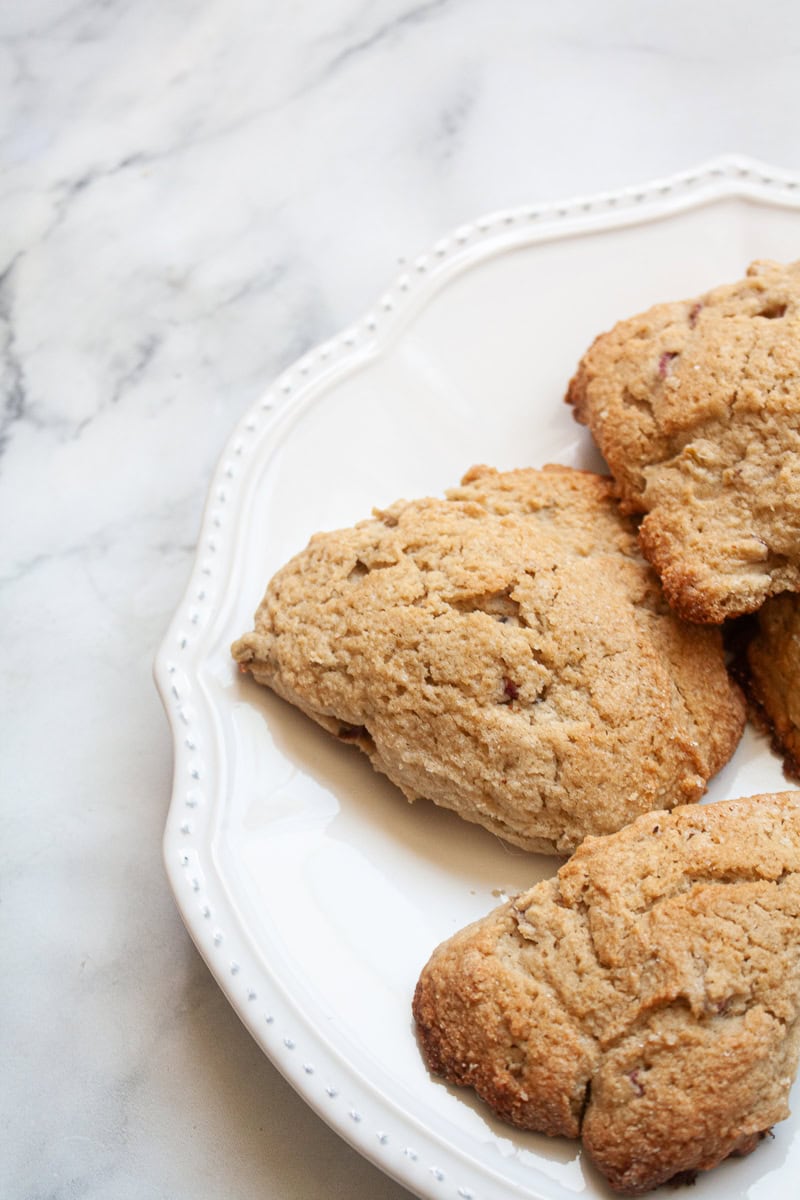
The Best Rhubarb Scones Recipe
I love a good scone and these gluten free rhubarb scones are at the top of my spring-into-summer baking list! Rhubarb is one of my favorite spring produce items, and I'm always eager to tuck into breads, crisps, bars, and scones. These lovely tidbits are one of the best ways to gently showcase rhubarb - you'll lightly fold chopped fresh rhubarb into a tender gluten free dough made from oat flour, almond flour, and heavy cream along with a good pinch of ground ginger. The resulting tender and buttery scones are beautifully flavored with rhubarb without it being too forward. I love these for summer breakfasts.
Rhubarb Scones Highlights
Scones are such a wonderful way to use fresh produce, and tart rhubarb is the best addition to these little morsels. Some of my favorite things about these scones are their:
- Tender crumb from a combo of oat and almond flours
- Kids like them. Yes! My girls absolutely loved these rhubarb scones!
- Rhubarb-y goodness
- Rustic and flavorful
What Does Rhubarb Taste Like?
Even though rhubarb is most often cooked with other fruit - like in a sweet-tart strawberry rhubarb jam - it's actually a vegetable. Distinguished by its ruby red hue (although - you will also find rhubarb in green or pinker varieties) and mouth-puckering taste, rhubarb is best enjoyed with sugar because it is very, very tart.
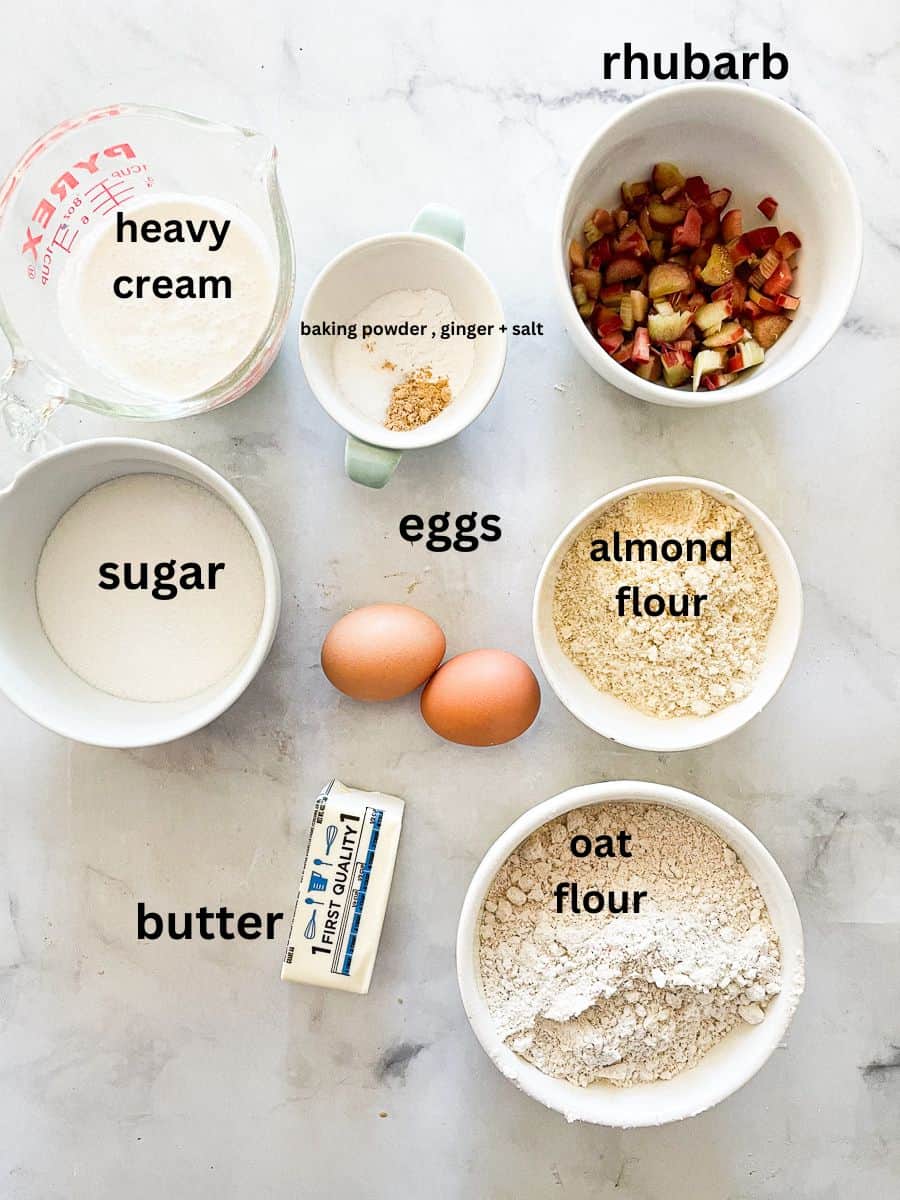
Ingredient Notes
Simple ingredients come together to make these beautifully rustic scones - here's a look at what you'll need.
- Granulated sugar - Just enough sugar balances the tartness of the rhubarb to make lightly sweet scones.
- Oat flour - Whole grain oat flour creates a fluffy crumb. Sub sorghum or brown rice flour if needed.
- Almond flour - A little fine ground almond flour adds structure and moistness to the scones.
- Baking powder - Check the expiration date on your baking powder to make sure it's still good before adding it to the batter.
- Ginger - I love the hint of warming ginger spice in these scones. You could also try cinnamon or cardamom.
- Salt - I always use fine sea salt in my recipes!
- Butter - Use unsalted butter and keep it in the fridge so that it stays very cold until just before you add it in.
- Rhubarb - Look for firm, fresh rhubarb in your market.
- Heavy cream - A touch of heavy cream adds richness. If needed, substitute whole milk but note that the scones won't be quite as rich.
- Eggs - You'll need large eggs for this recipe.
How to Make Gluten Free Rhubarb Scones
Here's how to make these scones - the more detailed instructions will be in the recipe card.

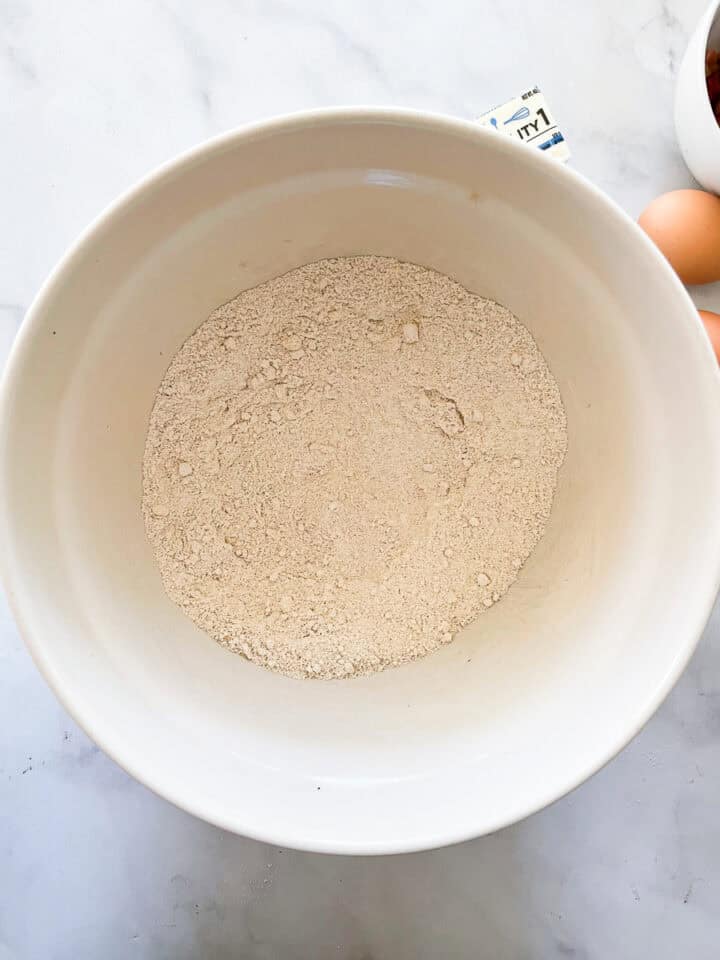
- Combine the dry ingredients. Place the sugar, oat flour, almond flour, baking powder, ginger, and salt in a large bowl.
- Whisk. Then whisk to combine.
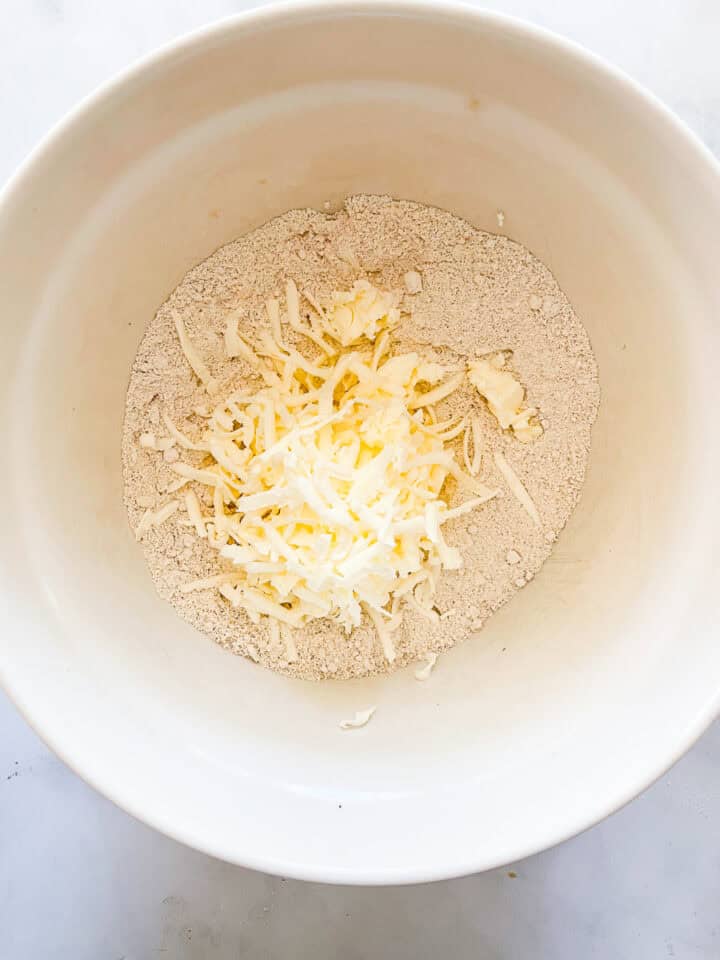

- Grate butter. Now grate in the butter using a box grater.
- Work it in. Using your hands or a fork, work in the butter.
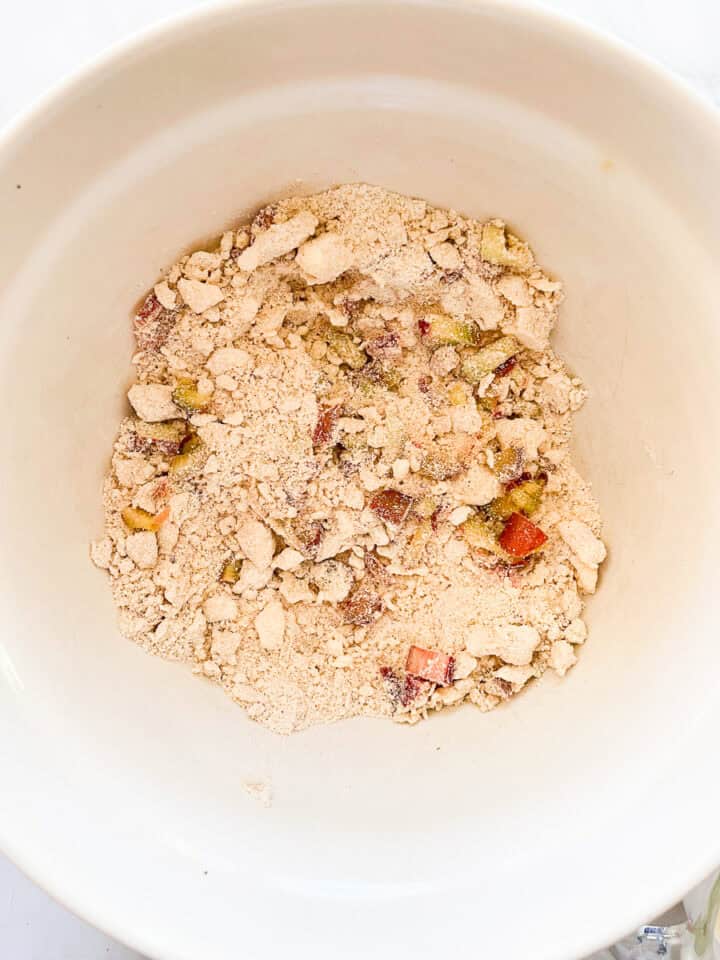
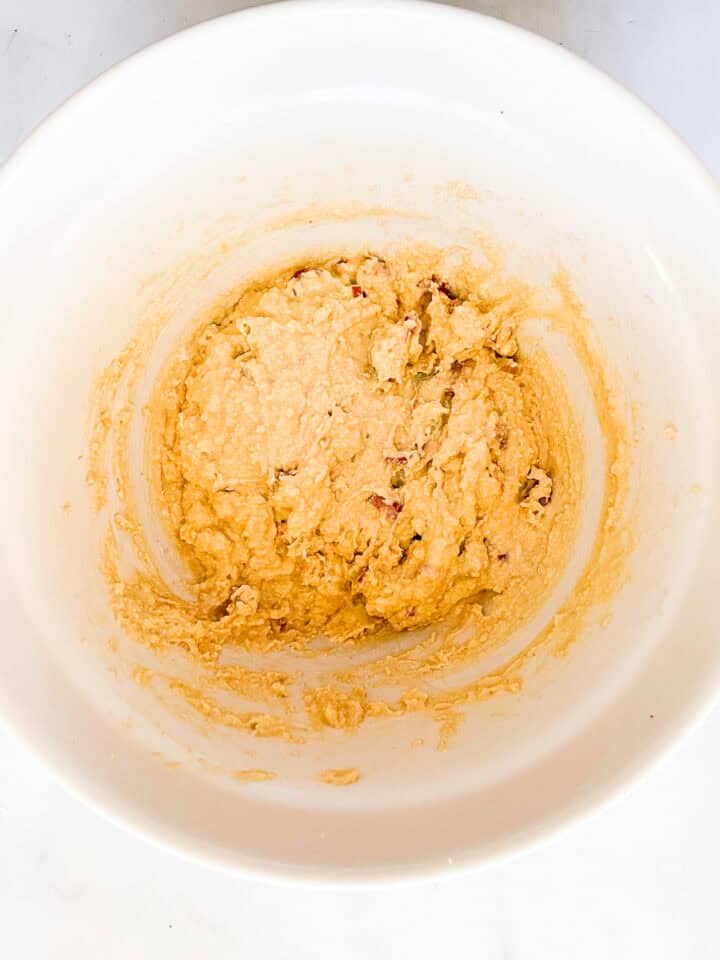
- Add rhubarb. Fold in the rhubarb.
- Add eggs. Whisk together the heavy cream and eggs, drizzle into the flour mix and stir to moisten.
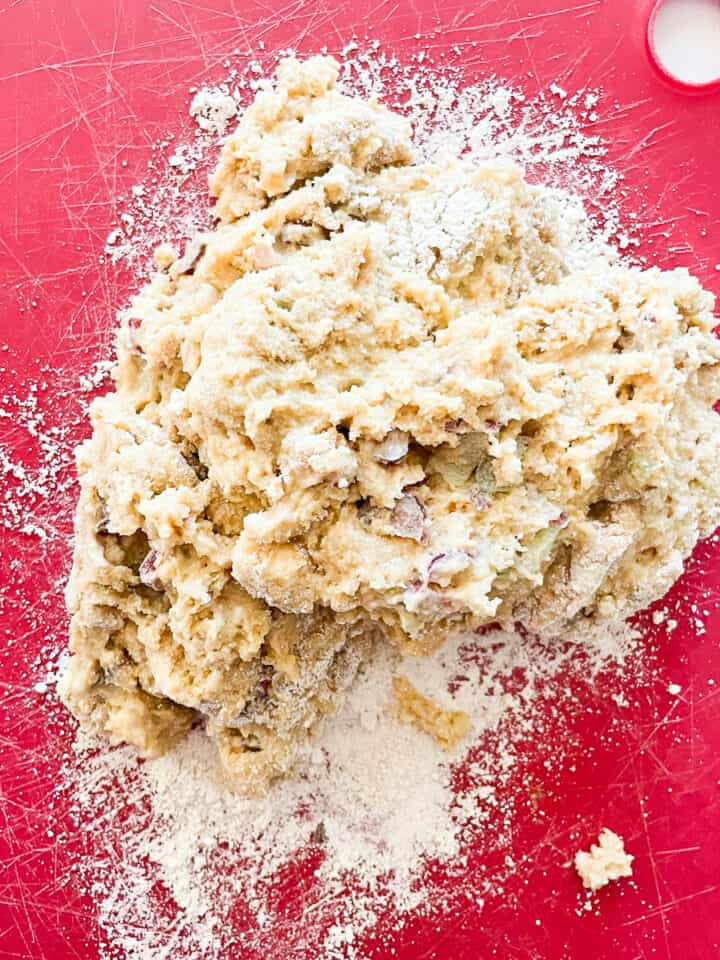

- Turn out dough. Using a little oat flour, turn out the dough on the counter.
- Knead. Using a little more oat flour, knead and work the dough together.
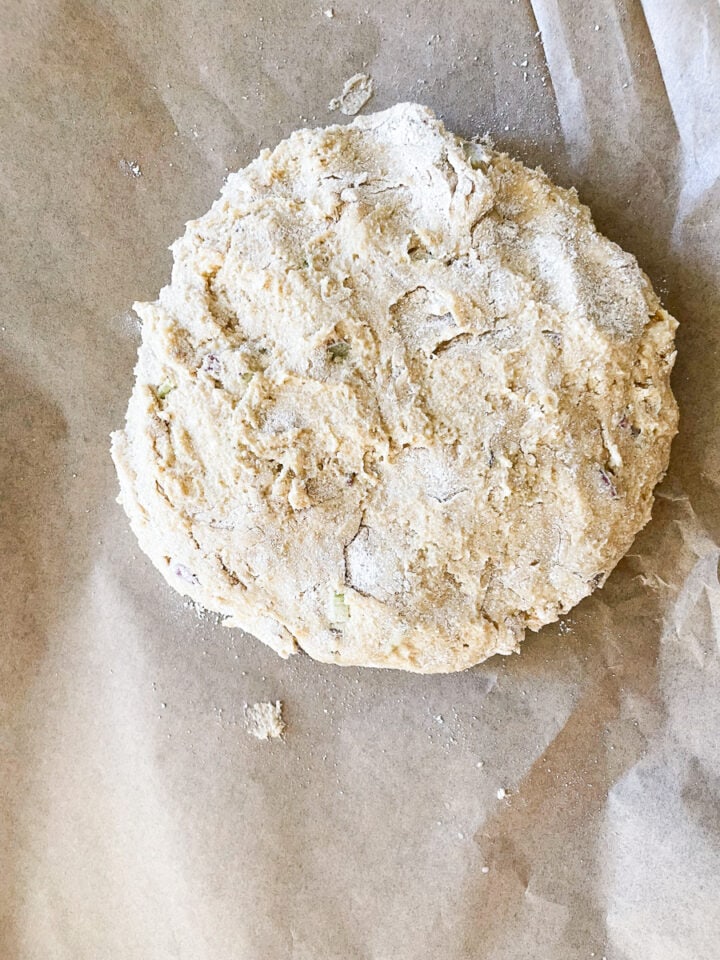
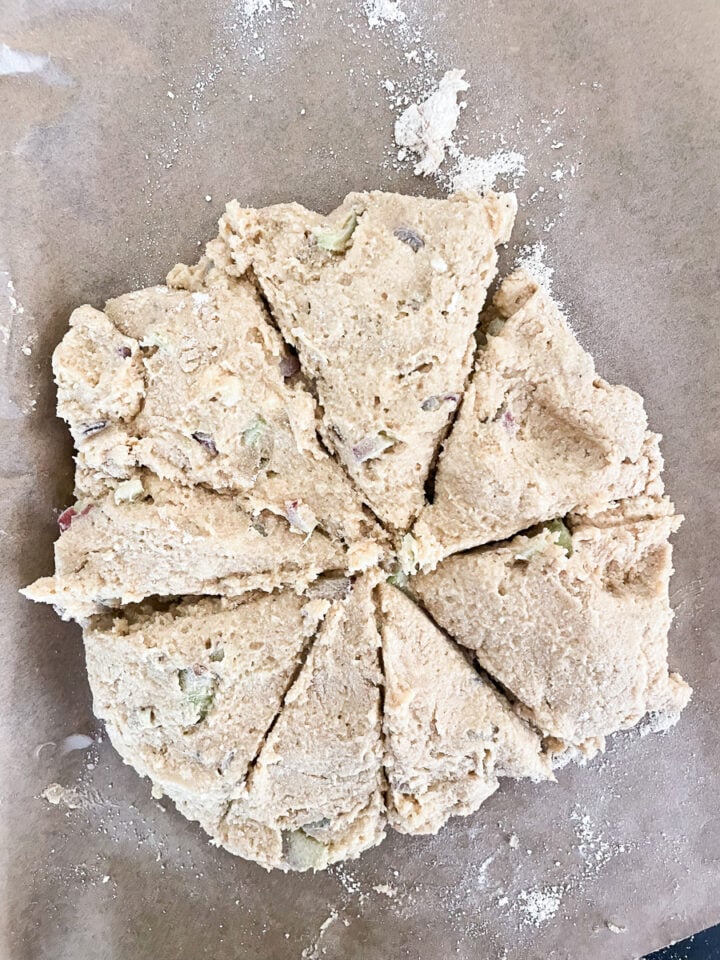
- Form. Form the dough into a disc.
- Cut. Use a sharp knife to cut the dough into 8 equal pieces.
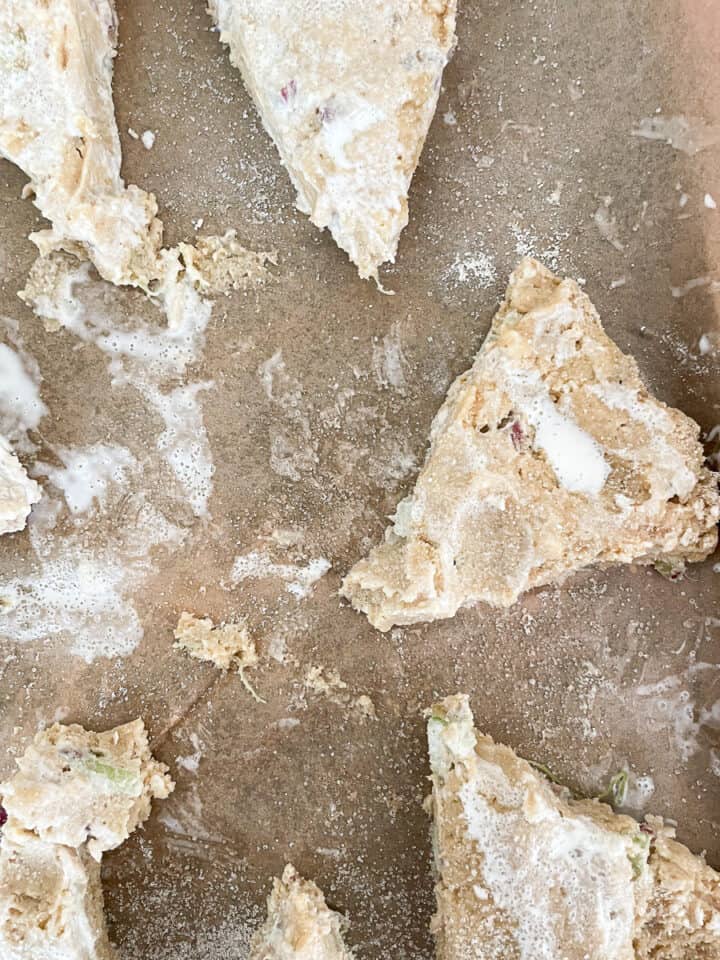
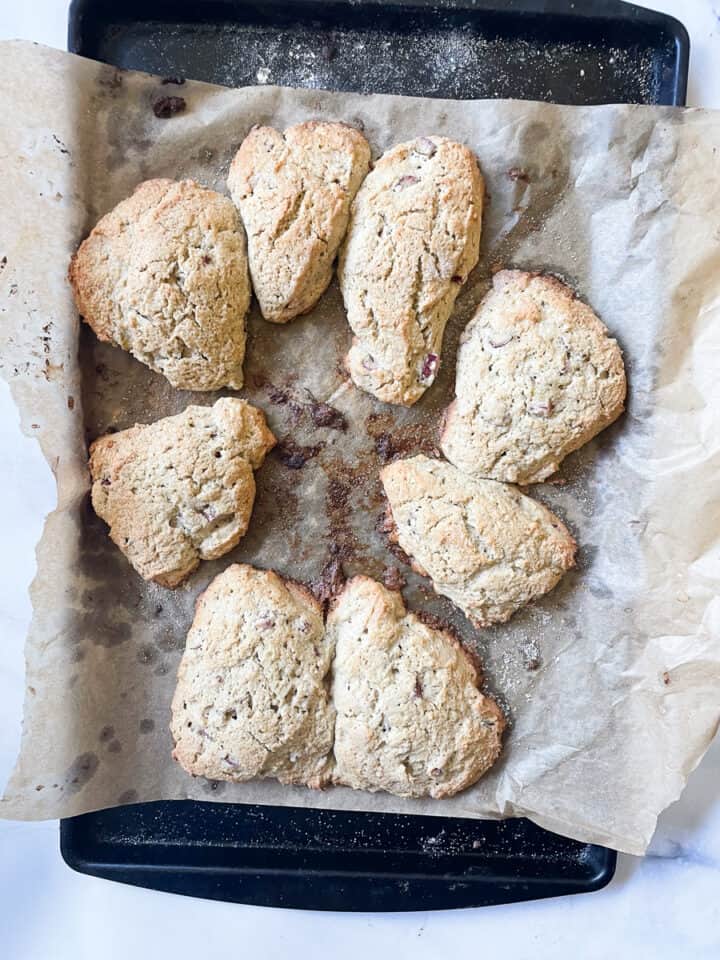
- Rest. Form the scones, then let them rest for at least 1 hour in the fridge.
- Bake. Lightly brush the scones with heavy cream, sprinkle them with sugar, then bake at 375°F for about 30 minutes. Cool on a rack for 20 minutes before serving.
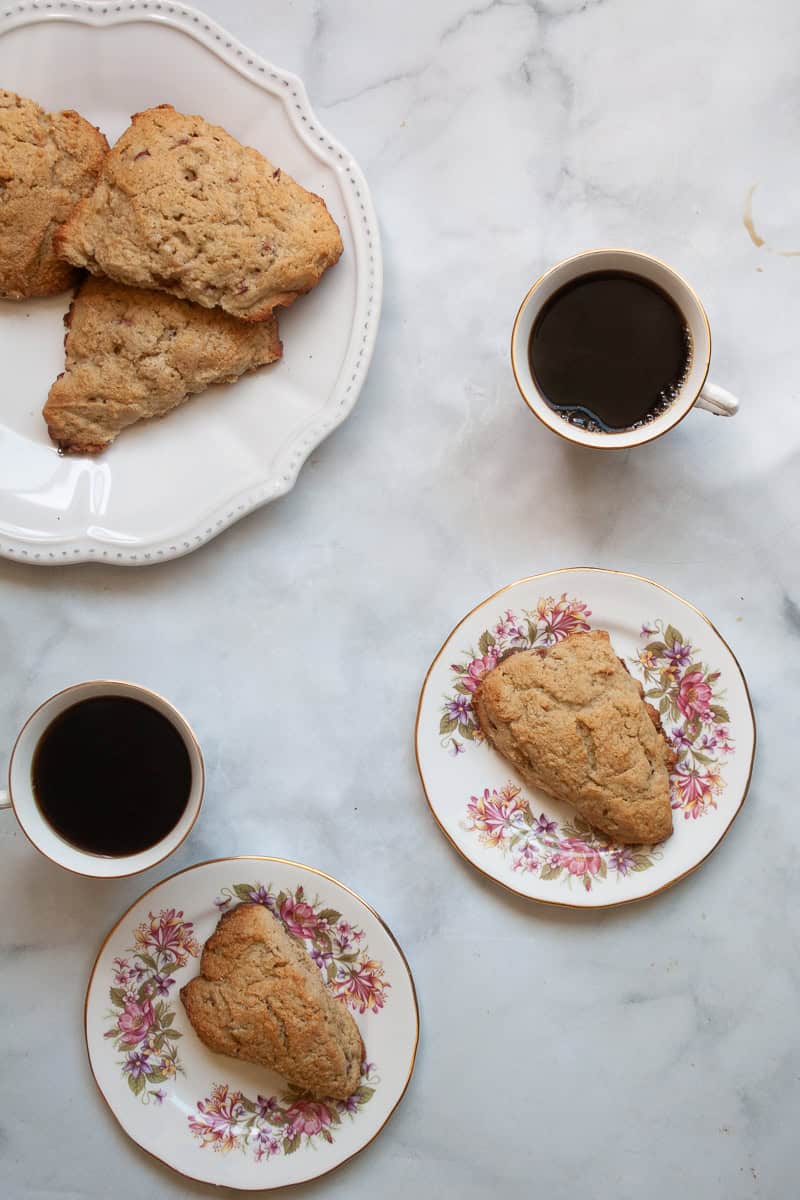
Recipe Tips & Substitution Options
- Oat flour substitute - If you don't eat oats, substitute sorghum flour or brown rice flour flour the oat flour by weight with great results.
- Almond flour substitute - Substitute another nut flour, tiger nut flour, or try substituting teff flour.
- Keep the ingredients very cold - This is the opposite of most baking advice, which asks you to bring your ingredients to room temperature! But keep your ingredients very cold, especially the butter, until you use them. You can keep butter in the freezer for maximum coldness.
- Grate the butter - I love grating butter into the scone dough instead of chopping up the pieces. This is what helps to make the scones flaky because as you work the butter into the dough some pieces will stay small (and will help "steam and puff") while other pieces soften and absorb into the dough, creating tenderness.
- Rest the dough - Make sure to let the batter rest for as long as possible in the fridge -- overnight is great if you can manage it.
- Use a 1:1 substitute - This recipe was developed specifically to use these two gluten-free flours. However, if you wish to use a gluten-free all-purpose flour, substitute it by weight for the oat and almond flours.
- Make them refined sugar-free - Use coconut sugar or maple sugar for the granulated sugar.
- Make them dairy-free - Swap very cold coconut oil or your favorite non-dairy butter for the butter. Switch the heavy cream for coconut cream (not coconut milk).

Storage Suggestions
These scones keep well, either on the counter or the fridge. I eat them at room temperature or I'll pop them in the oven to warm up a bit and then spread them with a a little softened butter. They're so good!
- Counter - Scones will keep in an air-tight container on the counter for up to 3 days.
- Fridge - Place the scones in an airtight container and store them in the fridge for up to 5 days.
- To Rewarm - Place the scones on a baking sheet and heat them in a preheated 300°F oven until warm. Or, toast them for a few minutes in a toaster oven.
More Gluten Free Rhubarb Recipes
- Gluten Free Rhubarb Bread
- Gluten Free Strawberry Rhubarb Bars
- Gluten Free Rhubarb Muffins
- Gluten Free Rhubarb Upside Down Cake

Gluten Free Rhubarb Scones
Ingredients
- ¾ cup granulated sugar
- 2 cups gluten-free oat flour (240 grams)
- ½ cup almond flour (65 grams)
- 3 teaspoons baking powder
- ½ teaspoon ground ginger
- ½ teaspoon fine sea salt
- ½ cup unsalted butter, very cold
- 1 cup diced rhubarb
- ½ cup heavy cream
- 2 eggs
Optional Topping
- 1 teaspoon heavy cream
- 1 teaspoon coarse sugar, or granulated sugar
Instructions
- Whisk in the sugar, oat flour, almond flour, baking powder, ginger, and salt in a large bowl. Whisk to combine. Grate in the cold butter using a box grater. Work in the butter with a fork and/or your hands until it comes together in pea-sized crumbs. Fold in the rhubarb.
- In a small bowl, whisk together the heavy cream and eggs. Drizzle over the flour mixture and stir together until moistened.
- Using a little oat flour, turn out the dough on the counter and, using a little more oat flour, knead and work the dough together until it is smooth and firm. Form dough into an 8-inch disc and, using a sharp knife, cut into 8 equal pieces.
- Line a baking sheet with parchment paper. Place the scones on the baking sheet and place the sheet in the fridge for at least an hour. You could also make these in advance and store them in a parchment-lined, air-tight container overnight for morning baking.
- When ready to bake, preheat oven to 375°F. Brush the scones with a little cream and sprinkle them with sugar, if using. Place the scones on their prepared baking sheet, then place in the oven and bake for about 30 minutes, until scones are lightly browned and firm. Remove from oven, let cool on the sheet for 5 minutes, then place on a rack to cool completely. Scones will keep, in an air-tight container on the counter, for up to 3 days.
Notes
- Oat flour substitute - If you don't eat oats, substitute sorghum flour or brown rice flour flour the oat flour by weight with great results.
- Almond flour substitute - Substitute another nut flour, tiger nut flour, or try substituting teff flour.
- Keep the ingredients very cold - This is the opposite of most baking advice, which asks you to bring your ingredients to room temperature! But keep your ingredients very cold, especially the butter, until you use them. You can keep butter in the freezer for maximum coldness.
- Grate the butter - I love grating butter into the scone dough instead of chopping up the pieces. This is what helps to make the scones flaky because as you work the butter into the dough some pieces will stay small (and will help "steam and puff") while other pieces soften and absorb into the dough, creating tenderness.
- Rest the dough - Make sure to let the batter rest for as long as possible in the fridge -- overnight is great if you can manage it.
- Use a 1:1 substitute - This recipe was developed specifically to use these two gluten-free flours. However, if you wish to use a gluten-free all-purpose flour, substitute it by weight for the oat and almond flours.
- Make them refined sugar-free - Use coconut sugar or maple sugar for the granulated sugar.
- Make them dairy-free - Swap very cold coconut oil or your favorite non-dairy butter for the butter. Switch the heavy cream for coconut cream (not coconut milk).


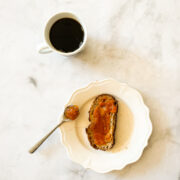
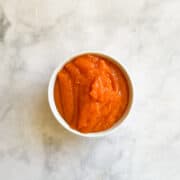
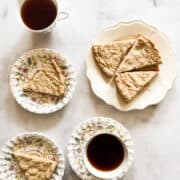


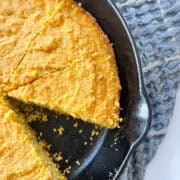
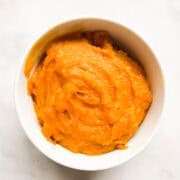
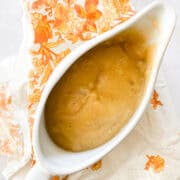


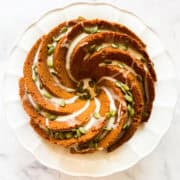
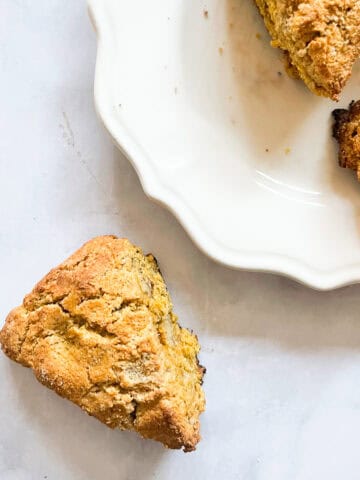

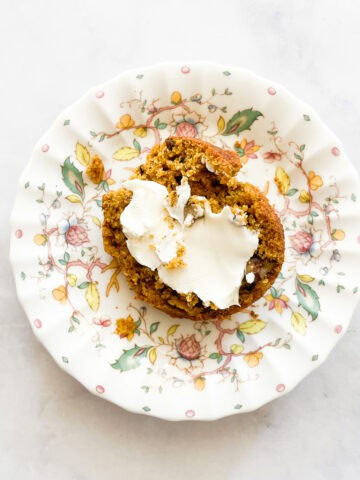
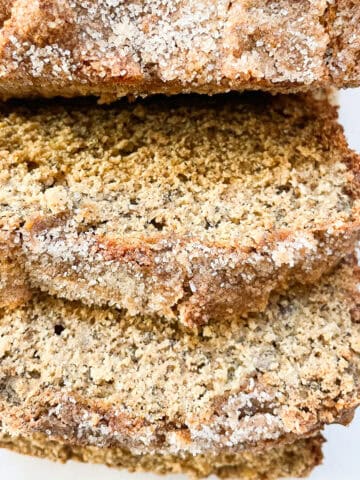
I'd love to hear from you! Please leave me a note.